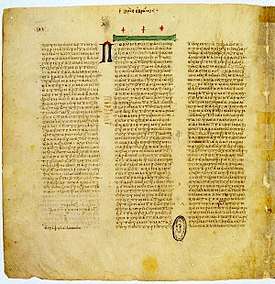2 Thessalonians 3
2 Thessalonians 3 is the third (and the last) chapter of the Second Epistle to the Thessalonians in the New Testament of the Christian Bible. Traditionally, it is believed to be written for the church in Thessalonica by Apostle Paul, likely in Corinth shortly after the first epistle (which was written in about 50-51 CE[1]),[2] although there were debatable charges that it is the work of a secondary imitator after Paul's death (in 70s to 100 CE).[3] This chapter contains a mutual prayer, warnings against loafers and the conclusion of the epistle.[4]
| 2 Thessalonians 3 | |
|---|---|
 A page of Codex Vaticanus containing Second Epistle to the Thessalonians 3:11–18 and Epistle to the Hebrews 1:1–2:2, from AD 325–350. | |
| Book | Second Epistle to the Thessalonians |
| Category | Pauline epistles |
| Christian Bible part | New Testament |
| Order in the Christian part | 14 |
Text
The original text was written in Koine Greek. This chapter is divided into 18 verses.
Textual witnesses
Some early manuscripts containing the text of this chapter are:
- Codex Vaticanus (AD 325–350)
- Codex Sinaiticus (330–360)
- Codex Alexandrinus (400–440)
- Codex Freerianus (c. 450; extant verses 8–10)
- Codex Claromontanus (c. 550)
Mutual Prayer (3:1-5)
This section contains a series of moral admonition and a prayer that the recipients get 'the ability to carry out the instructions'.[5]
Warning against Loafers (3:6-15)
The subject of this part is to address those who live 'in disorderly way' ('attaktōs), which should be avoided by the members of the church.[5]
Verse 10
.jpg)
- For even when we were with you, this we commanded you, that if any would not work, neither should he eat.[6]
- "When we were with you": refers to Paul's stay at Thessalonica in person, when the Gospel was first preached to the addressees.[7] The Ethiopian version has it in the singular person, "when I was with you, I commanded you".[7]
- "If any would not work, neither should he eat": This is a sort of a frequently used Jewish proverb,[8] "that if a man would not work, he should not eat". Also:[9]
"he that labours on the evening of the sabbath (or on weekdays), he shall eat on the sabbath day; and he who does not labour on the evening of the sabbath, from whence shall he eat (or what right and authority has he to eat) on the sabbath day?"
Conclusion (3:13-18)
Paul gives the final messages, puts his own handwriting as a sign of authenticity and ends with a benediction which has become standard.[10]
See also
- Jesus Christ
- Second Coming
- He who does not work, neither shall he eat
- Related Bible parts: 1 Thessalonians 4, 1 Thessalonians 5
References
- Esler 2007a, p. 1199.
- Best, E. (1972), A Commentary on the First and Second Epistles to the Thessalonians, Black's New Testament Commentaries (London: Adam £ Charles Black). p. 59; apud Esler 2007, p. 1213. Quote: 'to meet a new situation in respect of eschatology and a deteriorating situation in respect of idleness', although 'we do not know from where Paul received his information'.
- Esler 2007b, pp. 1213–1214.
- Esler 2007b, pp. 1218–1219.
- Esler 2007b, p. 1218.
- 2 Thessalonians 3:10 KJV
- John Gill's Exposition of the Entire Bible, – 2 Thessalonians 3:10
- Bereshit Rabba, sect. 14. fol. 13. 1. Echa Rabbati, fol. 48. 4. & Midrash Koholet, fol. 65. 4.
- T. Bab. Avoda Zara, fol. 3. 1.
- Esler 2007b, p. 1219.
Sources
- Esler, Philip F. (2007a). "71. 1 Thessalonians". In Barton, John; Muddiman, John (eds.). The Oxford Bible Commentary (first (paperback) ed.). Oxford University Press. p. 1199. ISBN 978-0199277186. Retrieved February 6, 2019.
- Esler, Philip F. (2007b). "72. 2 Thessalonians". In Barton, John; Muddiman, John (eds.). The Oxford Bible Commentary (first (paperback) ed.). Oxford University Press. pp. 1213–1220. ISBN 978-0199277186. Retrieved February 6, 2019.
External links
- 2 Thessalonians 3 King James Bible - Wikisource
- English Translation with Parallel Latin Vulgate
- Online Bible at GospelHall.org (ESV, KJV, Darby, American Standard Version, Bible in Basic English)
- Multiple bible versions at Bible Gateway (NKJV, NIV, NRSV etc.)